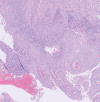HPV-associated Sinonasal Squamous Cell Carcinoma
- PMID: 39781091
- PMCID: PMC11706634
- DOI: 10.1055/a-2496-5240
HPV-associated Sinonasal Squamous Cell Carcinoma
Abstract
Human papillomavirus (HPV)-associated sinonasal squamous cell carcinoma (SNSCC) (HPV+ SNSCC) is a recently recognized entity that accounts for up to one-third of SNSCC. Although at present these cancers are not routinely tested for HPV, the incidence is increasing and HPV+ SNSCC is associated with superior survival outcomes compared with HPV- SNSCC. Here, we present the case of a patient with HPV+ SNSCC treated with endoscopic resection followed by postoperative radiation and review the literature summarizing epidemiology and management of this disease, with emphasis on the importance of HPV testing in SNSCC.
Keywords: endoscopic; human papillomavirus; sinonasal; squamous cell carcinoma.
The Author(s). This is an open access article published by Thieme under the terms of the Creative Commons Attribution-NonDerivative-NonCommercial License, permitting copying and reproduction so long as the original work is given appropriate credit. Contents may not be used for commercial purposes, or adapted, remixed, transformed or built upon. ( https://creativecommons.org/licenses/by-nc-nd/4.0/ ).
Conflict of interest statement
Conflict of Interest None declared.
Figures



References
-
- Fukuda K, Shibata A. Exposure-response relationships between woodworking, smoking or passive smoking, and squamous cell neoplasms of the maxillary sinus. Cancer Causes Control. 1990;1(02):165–168. - PubMed
-
- Oliver J R, Lieberman S M, Tam M M et al.Human papillomavirus and survival of patients with sinonasal squamous cell carcinoma. Cancer. 2020;126(07):1413–1423. - PubMed
-
- Ramkumar S P, Simpson M C, Adjei Boakye E et al.High-risk human papillomavirus 16/18 associated with improved survival in sinonasal squamous cell carcinoma. Cancer. 2023;129(09):1372–1383. - PubMed

